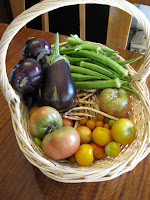My goal is to have an edible landscape. This means that a majority of plants have some sort of culinary purpose for me or for the beneficial wildlife I am trying to attract.
When you think of food production in terms of a landscape, it really opens your eyes to appreciate all qualities of the plants we grow to consume. You don’t need coleus or begonias when you can have an even more beautiful bed of Bright Lights Swiss Chard. Asparagus fern, why not just plain asparagus? Need something tall in the background? Grow corn. There are several varieties that have burgundy coloring in their leaves, stems, and silk that is just lovely. Forget about morning glories and plant Scarlet Runner Beans instead. They have the sweetest red flowers and the beans are delicious. Another favorite landscape plant of mine is Globe Artichoke. The plants grow into huge specimens with silver foliage. They are very dramatic and can yield a dozen or more tasty appetizers. I also love Fennel. The airy fronds dance in the wind and are a favorite snack for butterfly caterpillars.
I also expand my definition of an edible landscape to include wildlife I want to attract. I need birds in the yard to keep the bugs down, so I grow plants that will attract them. Amaranth (weed them into your salad), Echinacea, Cosmos, Barbados Cherry, Rose varieties that produce hips, Pigeon Berry, Lantana, and Chili Pequin all provide color and treats. Birds like low cover to hide in while they are scoping out the groceries, so I've included Bamboo Muhly and berry producing shrubbery like Agarita and Yaupon.
And what about that grassy lawn? Get rid of it. It is a total waste of water and human resources. Replace the blades with Thyme, Marjoram, Winter Savory, Peppermint or Oregano (or a blend of all of them.) They form a thick, green carpet that you can walk on. Heck, you can even mow them if you want (talk about a head rush though!) They stay low and don’t take nearly as much water to keep green. They also bloom and will attract bees and other pollinators to the garden. If you want more "real" grass, try a native Texas Sedge (Carex texensis), which is what I put in.
It takes courage to do this however, because your yard will not look like everyone else’s. Peer pressure can be hard to overcome and you can bet you’re efforts will generate plenty of comments. However, I’ve always found that including your neighbors in your plans and sharing the fruits of your labor go a long way to smooth the path. They’ll start to think you are a genius as you sit in your lawn chair amongst the fragrant herb lawn, sipping an ice tea watching them slog it out with the lawn mower. Wave to them and ask them to sit with you for a spell. You might just be able to find a second career as a landscape consultant.



No comments:
Post a Comment